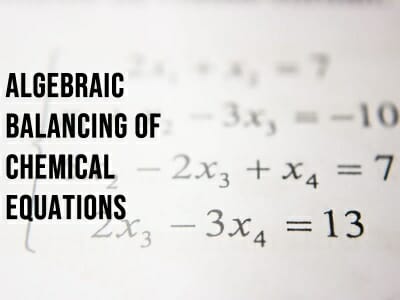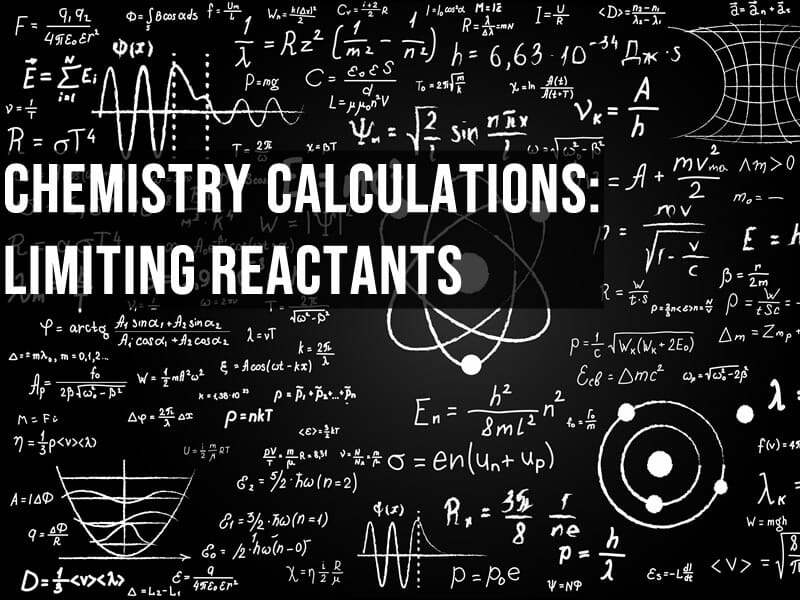
Balancing chemical equations using the algebraic method
In the last of my series on balancing chemical equations, we look at the algebraic method, which is useful for balancing the hardest equations
Whilst the combination of algebra and balancing chemical equations might sound horrifying, it’s not as bad as it sounds. The algebra part is pretty straightforward, nothing more difficult than the simultaneous equations you’d encounter at GCSE-level maths, if that.
That being said, it is a mathematical approach that is only suitable for mathematically-minded A Level or IB students. If you learn it, it can be a very fast way to balance difficult equations that are hard to balance by inspection, but there is no formal requirement to learn this method, nor should you ever need to use it to balance a chemical equation on an A Level or IB Diploma exam.
There are two algebraic methods, the normal algebraic method and a simplified version, which is the best way to crack the toughest equations. Let’s look at the algebraic method first.
Algebraic method for balancing chemical equations
The strategy for balancing chemical equations algebraically is as follows:
- Write a different letter coefficient in front of each compound in the equation
- Write algebraic expressions or rules for each element that equate its atoms on the LHS and RHS
- Substitute and simplify to obtain a rule that equates only two letter coefficients that you can solve
- Substitute the values into the other rules to obtain the balancing coefficients
That makes absolutely no sense I’m sure without an example, so here’s an equation to balance using this strategy:
_KMnO4 + _HCl → _MnCl2 + _KCl + _Cl2 + _H2O
First thing we do is give each compound a letter coefficient:
aKMnO4 + bHCl → cMnCl2 + dKCl + eCl2 + fH2O
Next, applying the Conservation of Mass, which tell us that the total number of atoms of each element must be the same on both sides, write algebraic rules for each element.
K: a = d
Mn: a = c
O: 4a = f
H: b = 2f
Cl: b = 2c + d + 2e
To explain the logic behind this using Cl as an example, we know that the number of chlorine atoms must be the same on both sides of the equation. On the reactant side, we would have a total of b chlorine atoms. On the product side, MnCl2 contains two chlorine atoms, so if its coefficient is c, it must contain 2c chlorine atoms, whilst KCl contains d chlorine atoms and so on, adding up the total number of chlorine atoms on the RHS.
There are too many unknowns here, but we can substitute the rules for K and Mn into the rule for Cl to get rid of c and d:
b = 2a + a + 2e
b = 3a + 2e
We can also get rid of b using the rule for H:
2f = 3a + 2e
And finally, get rid of f using the rule for O:
2(4a) = 3a + 2e
8a = 3a + 2e
5a = 2e, hence a = 2 and e = 5
Having now found two coefficients, substituting into the rules for Cl and O and using the fact that a = c = d = 2 solves for b and f:
b = 2c + d + 2e
b = 3a + 2e
b = 3 x 2 + 2 x 5
∴ b = 16
4a = f
∴ f = 8
2KMnO4 + 16HCl → 2MnCl2 + 2KCl + 5Cl2 + 8H2O
In the unlikely event this showed up on an exam paper as a balancing question, you would ordinarily use the redox balancing method but I think you’d agree that this method is faster.
Note that when you use the algebraic method, you may end up performing different substitutions in order to eliminate the unknowns. This is perfectly fine, there is no right or wrong approach.
Simple algebraic method for balancing chemical equations
Now, if in the above example you were thinking “hang on, if a = c = d, why introduce c and d at all? Why not simplify the whole thing?” you would have been right and this is where the simplified algebraic method comes in. This method does exactly that – it uses logic to reduce the number of unknowns you need to solve.
It’s the best method I know of for balancing extremely difficult equations and is a very fast method for balancing hard redox equations too, once you get the hang of it. The downside if there is one is that this method does need a little bit of intuition. By that, I mean some equations need you to apply certain balancing by inspection principles in order to simplify the algebraic expressions you end up needing to solve.
The procedure for using the simple algebraic method is below, but to be honest it will read like gobbledegook and the only way to make sense of it is to work through a lot of practise questions, which thankfully I have provided.
- Identify the element(s) appearing only once on the LHS and RHS of the equation
- If the element(s) is already balanced, write the same letter coefficient in front of its compounds
- If the element(s) is not balanced, write the letter coefficient in front of the compound containing the greater number of its atoms, then balance the element on the other side of the equation using the same letter coefficient (applying Conservation of Mass)
- Place letter coefficients in front of the remaining compounds.
- Minimise the number of letters needed by applying the Conservation of Mass and logic, so that coefficients representing an element on one side are expressed in terms of existing coefficients representing the element on the other side. The idea is to reduce the number of unknowns.
- Aim to use at least two letter coefficients.
- Write an algebraic rule for the remaining elements that equates them on each side of the equation, substitute and simplify to obtain solutions for each letter coefficient.
- Use the Conservation of Charge principle wherever possible as this can significantly reduce the number of unknowns (an example is given below)
We’ll use the same equation as above to show how this works:
_KMnO4 + _HCl → _MnCl2 + _KCl + _Cl2 + _H2O
This time, we’ll start by noticing that oxygen appears only once on each side. Applying the rules above, we’ll use the same letter coefficient in front of KMnO4 and H2O, putting a in front of KMnO4 and 4a in front of H2O, since logically the number in front of H2O must be four times the number in front of KMnO4 to balance oxygen:
aKMnO4 + _HCl → _MnCl2 + _KCl + _Cl2 + 4aH2O
Potassium and manganese also appear only once on each side, as does hydrogen. Using what I called the ‘forced coefficients’ rule in this blog on balancing chemical equations, we know that the coefficient in front of KCl and MnCl2 must also be a:
aKMnO4 + _HCl → aMnCl2 + aKCl + _Cl2 + 4aH2O
For hydrogen, the coefficient in front of HCl would have to be twice the coefficient in front of H2O, which is 8a:
aKMnO4 + 8aHCl → aMnCl2 + aKCl + _Cl2 + 4aH2O
That just leaves chlorine, which we’ll give the coefficient b:
aKMnO4 + 8aHCl → aMnCl2 + aKCl + bCl2 + 4aH2O
It’s now possible to write an algebraic rule for chlorine:
8a = 2a + a + 2b
5a = 2b, giving a = 2 and b = 5
2KMnO4 + 16HCl → 2MnCl2 + 2KCl + 5Cl2 + 8H2O
Here’s another example. This one comes from an A-Level chemistry past paper that students found difficult to balance according to the examiner report. The reaction features an unusual +6 oxidation state for iron:
__FeO42-(aq) + __H2O(l) → __O2(g) + __Fe(OH)3(s) + __OH–(aq)
The first step is to note that iron appears once on each side of the equation, so following the above guidelines, we’ll start by putting the letter coefficient a in front of FeO42- and Fe(OH)3:
aFeO42-(aq) + __H2O(l) → __O2(g) + aFe(OH)3(s) + __OH–(aq)
We can use Conservation of Charge to help simplify this problem. Since FeO42- and OH– are the only charged species, the coefficient for OH– must be double that for FeO42- – 2a in this case. Adding coefficients for H2O and O2, we get:
aFeO42-(aq) + bH2O(l) → cO2(g) + aFe(OH)3(s) + 2aOH–(aq)
We can now write expressions to balance oxygen and hydrogen, equating the number of each on the RHS and LHS:
Oxygen balance
4a + b = 2c + 3a + 2a
4a + b = 2c + 5a
b = 2c + a
Hydrogen balance
2b = 3a + 2a
2b = 5a
Hence, a = 2 and b = 5
Substituting these values into b = 2c + a gives c = 1.5
The balanced equation is thus:
2FeO42-(aq) + 5H2O(l) → 1.5O2(g) + 2Fe(OH)3(s) + 4OH–(aq)






I like this method and was aware from this earlier but I am not able to solve photosynthesis process by this method, I wish someone would help me!
really really good method, i wish i had seen this just before my exam last week :<
it hard to be presise
i am using the same method to teach my students but in a different way and its works perfectly
Hello sir send me your WhatsApp number so that you can teach me because am having difficulty here
Salute to those who invented this method
Very precise
Mind Blowing??…Great ??❤❤
Very fantastic
How does 5a = 3a?
Thanks!
Hello sir.. Could you take me on chemistry exercises?
Just INCREDIBLE.